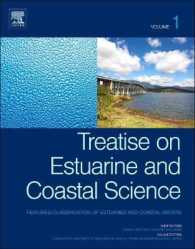- ホーム
- > 洋書
- > 英文書
- > Science / Mathematics
Full Description
This book started as a collection of lecture notes for a course in differential equations taught by the Division of Applied Mathematics at Brown University. To some extent, it is a result of collective insights given by almost every instructor who taught such a course over the last 15 years. Therefore, the material and its presentation covered in this book were practically tested for many years.
This text is designed for a two-semester sophomore or junior level course in differential equations. It offers novel approaches in presentation and utilization of computer capabilities. This text intends to provide a solid background in differential equations for students majoring in a breadth of fields.
Differential equations are described in the context of applications. The author stresses differential equations constitute an essential part of modeling by showing their applications, including numerical algorithms and syntax of the four most popular software packages. Students learn how to formulate a mathematical model, how to solve differential equations (analytically or numerically), how to analyze them qualitatively, and how to interpret the results.
In writing this textbook, the author aims to assist instructors and students through:
Showing a course in differential equations is essential for modeling real-life phenomena
Stressing the mastery of traditional solution techniques and presenting effective methods, including reliable numerical approximations
Providing qualitative analysis of ordinary differential equations. The reader should get an idea of how all solutions to the given problem behave, what are their validity intervals, whether there are oscillations, vertical or horizontal asymptotes, and what is their long-term behavior
The reader will learn various methods of solving, analysis, visualization, and approximation, exploiting the capabilities of computers
Introduces and employs Maple™, Mathematica®, MatLab®, and Maxima
This textbook facilitates the development of the student's skills to model real-world problems
Ordinary and partial differential equations is a classical subject that has been studied for about 300 years. The beauty and utility of differential equations and their application in mathematics, biology, chemistry, computer science, economics, engineering, geology, neuroscience, physics, the life sciences, and other fields reaffirm their inclusion in myriad curricula.
A great number of examples and exercises make this text well suited for self-study or for traditional use by a lecturer in class. Therefore, this textbook addresses the needs of two levels of audience, the beginning and the advanced.
Contents
Preface
1 Introduction
1.1 Motivation
1.2 Classification of Differential Equations
1.3 Solutions to Differential Equations
1.4 Particular and Singular Solutions
1.5 Direction Fields
1.6 Existence and Uniqueness
Review Questions for Chapter 1
2 First Order Equations
2.1 Separable Equations
2.1.1 Autonomous Equations
2.2 Equations Reducible to Separable Equations
2.2.1 Equations with Homogeneous Coefficients
2.2.2 Equations with Homogeneous Fractions
2.2.3 Equations with Linear Coefficients
2.3 Exact Differential Equations
2.4 Simple Integrating Factors
2.5 First-Order Linear Differential Equations
2.6 Special Classes of Equations
2.6.1 The Bernoulli Equation
2.6.2 The Riccati Equation
2.6.3 Equations with the Dependent or Independent Variable Missing
2.6.4 Equations Homogeneous with Respect to Their Dependent Variable
2.6.5 Equations Solvable for a Variable
2.7 Qualitative Analysis
2.7.1 Bifurcation Points
2.7.2 Validity Intervals of Autonomous Equations
Summary for Chapter 2
Review Questions for Chapter 2
3 Numerical Methods
3.1 Difference Equations
3.2 Euler's Methods
3.3 The Polynomial Approximation
3.4 Error Estimates
3.5 The Runge-Kutta Methods
Summary for Chapter 3
Review Questions for Chapter 3
4 Second and Higher Order Linear Differential Equations
4.1 Second and Higher Order Differential Equations
4.1.1 Linear Operators
4.1.2 Exact Equations and Integrating Factors
4.1.3 Change of Variables
4.2 Linear Independence and Wronskians
4.3 The Fundamental Set of Solutions
4.4 Equations with Constant Coefficients
4.5 Complex Roots
4.6 Repeated Roots. Reduction of Order
4.6.1 Reduction of Order
4.6.2 Euler's Equations
4.7 Nonhomogeneous Equations
4.7.1 The Annihilator
4.7.2 The Method of Undetermined Coefficients
4.8 Variation of Parameters
Summary for Chapter 4
Review Questions for Chapter 4
5 Laplace Transforms
5.1 The Laplace Transform
5.2 Properties of the Laplace Transform
5.3 Discontinuous and Impulse Functions
5.4 The Inverse Laplace Transform
5.4.1 Partial Fraction Decomposition
5.4.2 Convolution Theorem
5.4.3 The Residue Method
5.5 Homogeneous Differential Equations
5.5.1 Equations with Variable Coefficients
5.6 Nonhomogeneous Differential Equations
5.6.1 Differential Equations with Intermittent Forcing Functions
Summary for Chapter 5
Review Questions for Chapter 5
6 Series Solutions of Differential Equations 335
6.1 Power Series Solutions
6.2 Picard's Iterations
6.3 Adomian Decomposition Method
6.4 Power Series Solutions to Equations with Analytic Coefficients
6.4.1 The Ordinary Point at Infinity
6.5 Euler Equations
6.6 Series Solutions Near a Regular Singular Point
6.6.1 Regular Singular Point at Infinity
6.6.2 Inhomogeneous Equations
6.7 Bessel Equations
6.7.1 Parametric Bessel Equation
6.7.2 Bessel Functions of Half-Integer Order
6.7.3 Related Differential Equations
Summary for Chapter 6
Review Questions for Chapter 6
7 Introduction to Systems of ODEs
7.1 Some ODE Models
7.1.1 RLC-circuits
7.1.2 Spring-Mass Systems
7.1.3 The Euler-Lagrange Equation
7.1.4 Pendulum
7.1.5 Laminated Material
7.1.6 Flow Problems
7.2 Matrices
7.3 Linear Systems of First Order ODEs
7.4 Reduction to a Single ODE
7.5 Existence and Uniqueness
Summary for Chapter 7
Review Questions for Chapter 7
8 Topics from Linear Algebra
8.1 The Calculus of Matrix Functions
8.2 Inverses and Determinants
8.2.1 Solving Linear Equations
8.3 Eigenvalues and Eigenvectors
8.4 Diagonalization
8.5 Sylvester's Formula
8.6 The Resolvent Method
8.7 The Spectral Decomposition Method
Summary for Chapter 8
Review Questions for Chapter 8
9 Systems of Linear Differential Equations
9.1 Systems of Linear Equations
9.1.1 The Euler Vector Equations
9.2 Constant Coefficient Homogeneous Systems
9.2.1 Simple Real Eigenvalues
9.2.2 Complex Eigenvalues
9.2.3 Repeated Eigenvalues
9.2.4 Qualitative Analysis of Linear Systems
9.3 Variation of Parameters
9.3.1 Equations with Constant Coefficients
9.4 Method of Undetermined Coefficients
9.5 The Laplace Transformation
9.6 Second Order Linear Systems
Summary for Chapter 9
Review Questions for Chapter 9
10 Qualitative Theory of Differential Equations
10.1 Autonomous Systems
10.1.1 Two-Dimensional Autonomous Equations
10.2 Linearization
10.2.1 Two-Dimensional Autonomous Equations
10.2.2 Scalar Equations
10.3 Population Models
10.3.1 Competing Species
10.3.2 Predator-Prey Equations
10.3.3 Other Population Models
10.4 Conservative Systems
10.4.1 Hamiltonian Systems
10.5 Lyapunov's Second Method
10.6 Periodic Solutions
10.6.1 Equations with Periodic Coefficients
Summary for Chapter 10
Review Questions for Chapter 10
11 Orthogonal Expansions
11.1 Sturm-Liouville Problems
11.2 Orthogonal Expansions
11.3 Fourier Series
11.3.1 Music as Motivation
11.3.2 Sturm-Liouville Periodic Problem
11.3.3 Fourier Series
11.4 Convergence of Fourier Series
11.4.1 Complex Fourier Series
11.4.2 The Gibbs Phenomenon
11.5 Even and Odd Functions
Summary for Chapter 11
Review Questions for Chapter 11
12 Partial Differential Equations
12.1 Separation of Variables for the Heat Equation
12.1.1 Two-Dimensional Heat Equation
12.2 Other Heat Conduction Problems
12.3 Wave Equation
12.3.1 Transverse Vibrations of Beams
12.4 Laplace Equation
12.4.1 Laplace Equation in Polar Coordinates
Summary for Chapter 12
Review Questions for Chapter 12
Bibliography
Index








